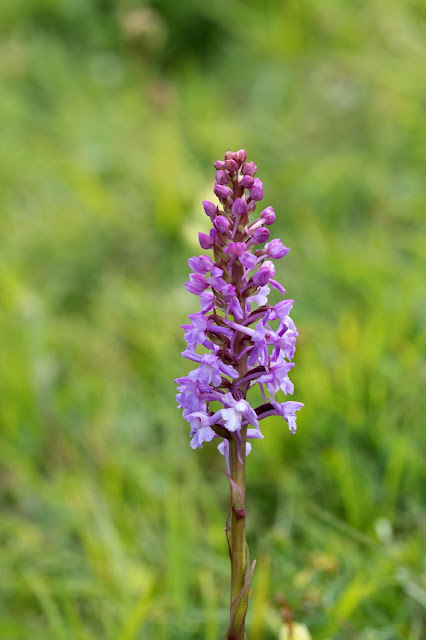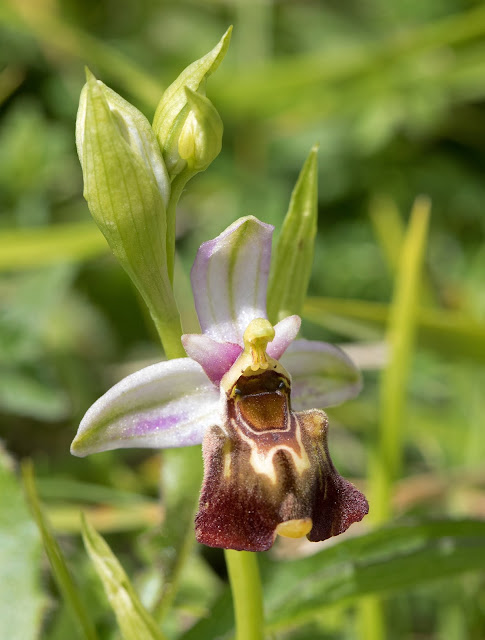We left early morning and, for once, had an uneventful journey, only the closure of the toll bridge in Sandwich causing a minor diversion. We decided to head for the beach via the private toll road and approach the golf course from the sea and as we turned down King's Avenue Martin said " I think I've seen one". Sure enough in the gardens and hedgerows were Lizard Orchids, tall flowering spikes that the residents had mown around. This was definitely going to be a doddle. We turned down the opportunity to photograph the first specimens and continued with our plan to park on the beach road. As we parked up and left the car we could see Lizard Orchids just about everywhere, hundreds of them in the dunes gently swaying in the breeze.
 |
| Recorded for posterity, the two spikes that greeted us as we parked up. |
 |
| No difficulty in finding them |
 |
| Lizard Orchid, Himantoglossum hircinum |
 |
| Lots of little lizards. |
 |
| Lizard Orchid, Himantoglossum hircinum |
 |
| Lizard Orchid, Himantoglossum hircinum |
 |
| Plenty yet to bloom. |
 |
| Lizard Orchid, Himantoglossum hircinum |
 |
| Lizard Orchid, Himantoglossum hircinum |
In the dunes were plenty of purple lollipops of the Pyramidal Orchid.
 |
| Pyramidal Orchid, Anacamptis pyramidalis |
 |
| Pyramidal Orchid, Anacamptis pyramidalis |
Plenty of really bright Viper's Bugloss, Echium vulgare in flower and the bumblebees were happy.
Sea Holly, Eryngium maritimum, sadly no flowers yet.
Next site was a revisit to Park Gate Down, only because there had been a report that Musk Orchids were in bloom in the third field. We had a bit of a shock as we entered the reserve, a sea of Chalk Fragrant Orchids clothed the slopes of all three fields. Not only the fragrants, huge numbers of Common Spotted Orchids were all in flower. I recorded a few and then went off in search of anything unusual and I managed to find an almost white CSO and the white form of CFO Var. albiflora.
 |
| Chalk Fragrant Orchid |
 |
| Chalk Fragrant Orchid |
 |
| Chalk Fragrant Orchid, Gymnadenia conopsea |
 |
| Chalk Fragrant Orchid, Gymnadenia conopsea |
 |
| Chalk Fragrant Orchid, Gymnadenia conopsea |
 |
| Chalk Fragrant Orchid, Gymnadenia conopsea Var. albiflora |
An almost white specimen of the Common Spotted Orchid, Dactyorhiza fuchsii
In the third field we found Greater Butterfly Orchids which I recorded.
 |
| Greater Butterfly Orchid, Platanthera chlorantha |
 |
| Greater Butterfly Orchid, Platanthera chlorantha |
 |
| Greater Butterfly Orchid, Platanthera chlorantha |
The search for Musk Orchids had proved fruitless so I sat down and had my lunch pondering what to do next. There were lots of small dried up Common Twayblades and these were distracting - just similar enough to the Musk to cause you study more closely.
I was just about to give up when I spotted a tiny little pale yellow spike nestling in the grass. As this area was a tad vulnerable I did a careful search to ensure that we would not damage anything before photographing the diminutive and delicate subject. In the end we found three, two normal size and one that really amounted to a half.
 |
| Musk Orchid, Herminium monorchis |
 |
| Musk Orchid, Herminium monorchis |
Well we were certainly having a good day. Then Martin suggested we revisit the Late Spider Orchid site. We had visited nearly a month earlier and all the specimens were in tight bud. I have a criterion that to tick an orchid then at least one flower must be open and visible. After that visit I went off to the Pyrenees but Martin had returned and recorded the orchids. I had given up seeing one this year but magically several were still in bloom and one or two looking fresh.
 |
| Late Spider Orchid, Ophrys fuciflora |
 |
| Late Spider Orchid, Ophrys fuciflora |
 |
| Late Spider Orchid, Ophrys fuciflora |
So the end of a great day where we saw at least 10 species of orchid and amazingly the Lizards were the first I have seen in the UK. I have a suspicion that our orchid hunting will start to get a little more difficult from here on in - but I have to admit it has been great fun so far.



















